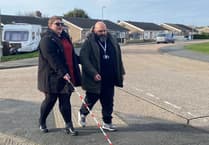FOR an older generation of Foresters, authors such as Winifred Foley, Harry Beddington and Leonard Clark helped tell life stories of the Dean for a large part of the 20th century.
The trio of writers were each very different but each was a well-known figure in the east of the Forest around Cinderford.
A giant landmark mural in the centre of Cinderford celebrates their legacy and serves as reminder to a new generation.
Winifred Foley found fame, both in the UK and internationally, later in life with her memoir A Child in the Forest which told of her childhood in what was the remote Forest of Dean in the 1920s.
Leonard Clark was a nationally notable literary editor and poet whose circle included people of the stature of Poets Laureate Ted Hughes and Sir John Betjeman.
Harry Beddington was a poet, champion of Forest dialect and an astute commentator on life in the Dean.
The new mural was commissioned by the Reading the Forest project and painted by Forest-based artist Tom Cousins.
The artwork is, appropriately given its literary subject, on the side of the Ripping Yarns wool shop in Woodside Street.
Three generations of Winifred Foley’s family and the grandson of Harry Beddington were present for the celebration marking the completion of the mural last Wednesday (July 18).
The mural was well-received by the families and has also been praised by Leonard Clark’s family.
Reading the Forest’s principal investigator, Jason Griffiths, said it was commissioned “to celebrate and raise the profile of the Forest’s fantastic literary heritage.”
Roger Deeks, who leads the project with Mr Griffiths, added: “This piece of public art is about marking the achievements of these writers, and we want them to act as an inspiration for young people in the Forest too,”
The mural was made possible through the support of the University of Gloucestershire, and the Foresters’ Forest Heritage Lottery programme.
Winifred Foley, who was a big film fan, would no doubt have enjoyed the fact that the building belongs to Karen and Andy Lougher, owners of Cinderford’s Palace Cinema.
Jason said: “It is important to memorialise these writers as they were quite significant and popular but they are in danger of being forgotten.”
“Winifred Foley was very significant as someone who reached national and international audiences with her writing.
“Leonard Clark was a more serious poet and literary editor who had connections with figures such as Ted Hughes and John Betjeman.
“Harry Beddington was rooted in Cinderford and wrote amusingly and compellingly in Forest dialect.
“There was always more to his characters than met the eye.
“We hope people will be inspired to go away and find out more about them all.
Artist Tom Cousins will soon be starting on a mural in Coleford depicting important authors from the west of the Forest.
The three to be featured on the Coleford mural will be playwright Dennis Potter of Berry Hill, Yorkley poet FW Harvey and Coleford author Joyce Latham who wrote two memoirs about growing up in the Forest in the 1930s and 1940s.
Reading the Forest also has plans to release an anthology of works by Forest authors of the 19th and 20th centuries.
Jason said: “There are some people who are passionate about the Forest literary heritage but the anthology is a way of bringing it to the attention of a wider audience.
“We also want to flag up to you if you’re from the area that you can achieve great things.”
A leaflet giving more details about the lives and works of the authors is available from Artspace in Woodside Street or Cinderford Library in Belle Vue Road.
Jason said: “We have a small, dedicated team of volunteers helping us do the research and organise events, and local libraries have really supported the project.
Reading the Forest brings together academics from the University of Gloucestershire, who are based in the Forest, and local volunteers to highlight the rich literary heritage of the Dean.
It is funded by the university and Heritage Lottery Fund and is part of the Foresters’ Forest project which is working to highlight the history, culture and heritage of the area.
For more information, visit www.readingtheforest.co.uk
-----
“We were all astonished” at book’s success
RECOGNITION as an author came later in life for Winifred Foley with her best-selling memoir A Child in the Forest and was completely unexpected, said her daughter, Jenny Townsend.
“She was a fantastic mum and seemed to be completely fulfilled by her job as a mum – it wasn’t until empty nest syndrome came that her old ambitions to do something and make a mark came back.”
Jenny, other members of the Foley family and the grandson of writer Harry Beddington were at an event last Wednesday to mark the completion of a mural featuring Winifred, Harry and Leonard Clark.
She told the Review: “As long as she could be.a mum and a granny she was happy but when that role diminished, she looked for something more.
“She always had ambitions for something more.”
Jenny believes the main motivation for writing the book about her childhood in Brierley near Cinderford in the 1920s was to “make her father live on”.
Winifred was born in 1914 to Margaret and Charlie Mason but her father was killed in a pit accident in 1945.
Later she began writing about her early childhood and sent some of the exercise books to the BBC.
They were made into a radio script for Women’s Hour and when A Child in the Forest was published in 1974 it became an instant hit.
Jenny said: “I think the main motivation for her was to make her father live on, she never got over the loss of her dad.
“She was trying in some ways to preserve his memory and celebrate him.
“Sadly it wasn’t always seen as celebration of him but certainly was the intention and I believe it was successful.
“Her initial motivation was her father, second was to celebrate the landscape of the Forest and the communities of the Forest and she had an itch to scratch but it was a political itch.
“She was very political and in later life she was a pacifist, she really did beat her drum about those things
“I think she did seek recognition – it was her way of not dying. I think she always wanted to leave a legacy.
“We were astonished by the success of it – for the first time in her life she had more money than was strictly necessary to eat.
“My dad was bought a pair of pyjamas, a dressing gown. He’d never had a dressing gown in his life.
“At Brierley it was right in the Forest, your vision was limited by trees and it was a focused, concentrated, passionate world and I think that was the
impetus for her.”
Winifred’s success also had an impact on her her husband, Syd.
“She was out of school at 14 and into domestic service so she didn’t have the benefit of an education.
“We thought dad was the clever clogs and we’d always ask him things.
“He was a bit stunned later in life when she got all this recognition and he was reduced to just chauffeuring her around.
“It was a strange turnout late in life in her 60s.”
-----
Winifred Foley
WINFRED Foley’s route to becoming a best-selling author was unconventional to say the least.
In the late 60s, she responded to a radio appeal by a social historian for listeners to send in unpublished material.
Winifred sent in some of her writings about growing up at Brierley near Cinderford in the 1920s.
The historian, John Bennett, passed it onto radio producer Pamela Howe and it was serialised for Radio 4’s Women’s Hour.
Her story of growing up in the Forest and of her terrible homesickness after being sent to work as a domestic servant in London at the age of 14, was published in 1974 as A Child in the Forest.
The book was dramatised for television and Winifred, an accomplished performer of her work, made several recordings for TV and radio.
She also wrote several short novels and a play and among her other works were No Pipe Dreams for Father (1977), Back to the Forest (1981) and Village Fates (2000).
She died aged 94 in 2009, shortly before the release of another edition of her most famous work.
----
Harry Beddington
HENRY John Beddington was the last of 13 children born to coal miner Henry Beddington and his wife Louisa in Ruspidge on the outskirts of Cinderford in 1901.
Like Leonard Clark, Harry lived on Belle Vue Road in Cinderford.
A accident as a boy meant he was almost blind in one eye which meant he was unable to sign up for military service when the Second World War broke out.
It was around that time that he started writing for local drama groups and his play Footing the Bill, won a prize at the first Cheltenham Festival in 1944.
That play was written entirely in Forest dialect and he became of champion of Forest talk in his poetry and prose.
He wrote for, and performed with, the Mintec Players — Cinderford Mining Technical College — and was a regular contributor to the Dean Forest Mercury.
Harry was an astute observer of the Forest and, through his character Jolter, painted a rich picture of local characters.
Among his books were: Forest of Dean Humour (1961), Forest Acorns (1963) and Forest HumourI (1977).
Harry died in 1986 at the age of 85.
-----
Leonard Clark
BORN in 1905 on Guernsey, Leonard Clark became an “adopted son” of Cinderford and prolific writer.
He worked as a school inspector, advising on education, edited many poetry collections for children and a large number of his hundreds of poems were for children.
He had a passion for nature which was reflected in his writing and which often describes the woods, fields and people of the Forest where he grew up.
Among his works were Green Wood (1962), A Fool in the Forest (1965), Grateful Caliban (1967) and An Inspector Remembers (1976).
He was adopted by Mrs Sarah Annie George, of Belle Vue Road, Cinderford and in Green Wood describes his arrival at Newnham station to the sound of a brass band.
He was admired by Poet Laureate Ted Hughes and other major poets of the time and was awarded an OBE in 1966.
He died in 1981 and is buried at St Stephen’s Church in Cinderford where there is a plaque to his memory.




